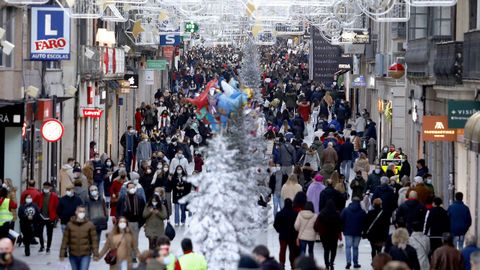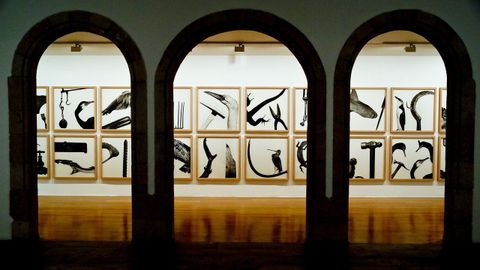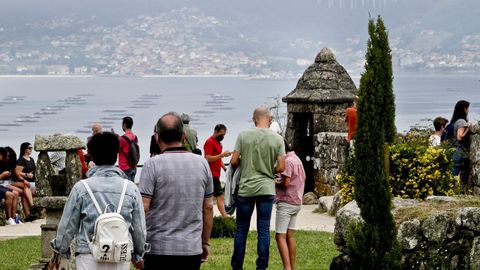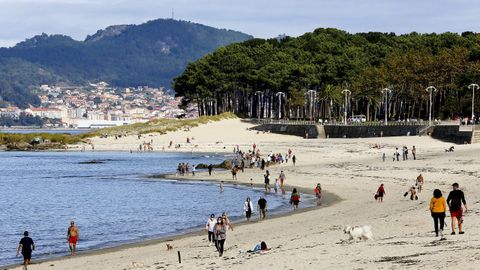
Taking in all the lights and attractions is the perfect excuse to discover the charms of one of Galicia?s most cosmopolitan cities
12 dic 2021 . Actualizado a las 21:12 h.The Vigo Christmas lights switch-on attracts thousands of visitors every year. If you are planning to visit the city of Vigo to take in the lights, do some early Christmas shopping at the craft market, or have a go on the rides, why not make the most of it to do some sightseeing.
You need look no further than the city to enjoy a winning combination of heritage, leisure and nature that few other places can offer. Of Celtic origin, Roman past, seafaring culture and industrial present, the city has been the backdrop of major events such as the Battle of Vigo Bay and key social movements such as La Movida. Strolling through its streets or visiting its squares or museums are just some of the things you can do in the city. Here are ten places to visit if you’re looking to enjoy some quality time this Christmas in Vigo.
La Alameda

Many of Vigo’s Christmas attractions will be located in and around Plaza de Compostela, better known as La Alameda. There you will find the Cíes Market, a huge collection of Christmas stalls where visitors can get some early Christmas shopping done while strolling among statues and gardens. The area is already a vibrant and lively place and becomes even more so as Christmas approaches. Surrounded by historical buildings, such as the Casa de Correos y Telégrafos, it is popular part of the city for night-life and leisure.
Parque de la Alameda is Vigo’s most central park. It boasts a wide range of flowers, including camellias, and trees such as horse chestnuts, all beautifully arranged to form a botanical garden. And for several months now it has been home to the Dinoseto, a dinosaur-shaped bush that has become a much-loved attraction and the star of endless selfies. It was moved from the Porta do Sol because of the construction work going on there. Yet the tyrannosaurus is not the only animal that inhabits Plaza de Compostela. Before his arrival there was already a stone zoo featuring statues such as a hyena, a giant snail, or a goat.
Port area

Lying a short distance from La Alameda is the port area, an essential place to visit for those looking to learn more about the history of Vigo and its traditional ties with the open sea. If you stroll along the Paseo de Montero Ríos and As Avenidas, where the famous O´Marisquiño festival is held, you can take in some of the city’s most iconic locations, including the Club Náutico marina and the statue of Jules Verne. The writer devoted a whole chapter of his novel Twenty Thousand Leagues Under the Seas to the city, thus fuelling the legend of the treasure of Rande, and even visited the city.
Also not to be missed are the Transatlantic Pier and its Maritime Station, where you can take in some breath-taking views of the surrounding area. Another place not to be missed is the fishing port and the fish market, a mainstay of the city’s local economy.
Casco Vello (historic quarter)

The port is the heart of Vigo and the city has grown out around it. Lying opposite to the fish market is Plaza de O Berbés, the city’s historic quarter. The area is made up of arcades, narrow streets and seafaring houses; a small fishing village within a big industrial city.
O Berbés is also one of the gateways to the Casco Vello (historic quarter), where the city’s seafaring roots combine with gems such as the Co-Cathedral of Santa María, popularly known as La Colegiata. Tasting the famous oysters in the Mercado da Pedra, strolling among traditional arts and crafts in streets such as Cesteiros or sampling local wines in and around Plaza de la Constitución are just some of the many things you can do in the area.
Calle del Príncipe

If you’re looking to explore modern Vigo, you simply have to walk along Calle del Príncipe. The city’s main shopping street is always a vibrant and lively location and even more so at Christmas time. As well as lights, shops and museums such as MARCO, the area boasts two monuments that should not be missed. At one end we have Porta do Sol, where we can find the famous O Sereo (Fishman) statue. And at the other end lies A Farola de Urzáiz (Urzáiz Streetlight), one of the traditional meeting points for the people of Vigo atop which the giant Christmas ball is placed.
MARCO museum

Calle del Príncipe is home to one of the city’s most important cultural centres. Vigo Museum of Contemporary Art (known as MARCO) is located in the former prison and court building and is listed as an Asset of Cultural Interest. MARCO hosts temporary exhibitions of various artistic disciplines, from painting to film, and has a distinctly avant-garde look to it. It also offers an extensive programme of educational activities and events.
Praza de América

Another corner of the city that hosts numerous festivities is Praza de América. Hundreds of people gather there every New Year’s Eve to eat grapes and see in the New Year. The huge clock on the face of Instituto Santa Irene, one of the most emblematic buildings of Vigo’s civil architecture, chimes the final seconds in the countdown to New Year’s Day.
Located in the As Travesas district, the square is also home to Porta do Atlántico, a huge monument featuring fountains that pays tribute to the thousands of Galician emigrants who set sail from the port of Vigo headed for the Americas.
Churruca

The sea, industry and emigration are some of the elements that define the history of Vigo. But turning to more recent events in the city’s history, we would be remiss not to mention the underground and countercultural Vigo of the 1980s, when it was the symbol of La Movida movement in Galicia. Before competing with New York for the Christmas lights, Vigo and Madrid used to battle it out for which city could offer more in terms of culture and leisure.
The Churruca district was one of the icons of La Movida and offers some of the best night-life in Vigo. The indie heart of the city features an endless number of pubs where you can have a beer or two and listen to all kinds of music. The bars and venues also offer a packed programme of concerts and leisure activities.
Monte de O Castro

To really appreciate the city in all its beauty, we always recommend heading up to one of its many viewpoints. Perhaps the most notable is the vantage point in Monte O Castro park. A place offering one of the best views of Ría de Vigo (Vigo estuary) and for taking a trip through Vigo’s history while strolling through one of its many green areas. To complement the city’s rich historical heritage, the park features playgrounds, skate parks, monuments and a botanical garden.
O Castro was the place that the first settlers of the city called home. A distant memory that is kept alive by the O Castro Site located on the slopes of the hill, which dates from the 3rd century BC. If we continue our climb through the park, we soon come across a set of anchors to commemorate one of Vigo’s greatest historical events: the Battle of Vigo Bay. And lying atop the hill we have the Fortress of O Castro, a medieval fort used to defend the city against English marauders even before the famous battle.
Praia de Samil (Samil Beach)

Ría de Vigo (Vigo estuary) offers numerous beaches where you can take a break from the Christmas hustle and bustle and enjoy the sea breeze. If we had to pick one, however, it would be Praia de Samil (Samil Beach). A kilometre of white sand surrounded by all kinds of services and facilities. Swimming pools, basketball courts, skating rinks, green areas and cafés make this urban beach the perfect place to spend a relaxing afternoon.
Cíes Islands

Vigo plays home to one of Galicia’s greatest natural treasures: the Cíes Islands. Galicia’s most famous archipelago possesses enormous natural and cultural heritage and is part of the Atlantic Islands of Galicia National Park. The diversity of its flora and fauna combines with a picture-postcard landscape of idyllic beaches, crystal-clear waters and spectacular cliffs.
The Cíes Islands, which form a kind of natural barrier at the entrance to the estuary, are an absolute must-see if you’re ever in Vigo. To reach them, you will need to take one of the many boats that depart from the city. A perfect excuse to enjoy some nautical tourism this Christmas!
